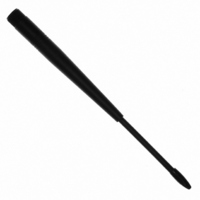0600-00027 Laird Technologies, 0600-00027 Datasheet - Page 44

0600-00027
Manufacturer Part Number
0600-00027
Description
ANTENNA 915MHZ 1/2WV 7" RPSMA
Manufacturer
Laird Technologies
Specifications of 0600-00027
Antenna Type
Whip: 1/2 Wave, Swivel, Tilt (Right Angle)
Number Of Bands
1
Frequency
902MHz ~ 928MHz
Vswr
2
Gain
2dBi
Termination
RP-SMA
Mounting Type
Connector
Height (max)
8.25" (209.5mm)
Impedance
50 Ohms
Technology Type
1/2 Wave Wireless Transceiver Antenna
Termination Style
RPSMA
Lead Free Status / RoHS Status
Lead free / RoHS Compliant
Lead Free Status / RoHS Status
Lead free / RoHS Compliant, Lead free / RoHS Compliant
Appendix III – API
Appendix III - API
I. Daisy Chain / Repeater
With the use of API commands a daisy chain or repeater can be implemented easily with the AC4790. Radio A would
send a packet to radio B which would store the data in its buffer. When the session between A & B has ended, radio B
initiates a session with radio C which in turn stores the data until the current session has ended. Radio C will then initiate
a session with radio D and so on. Radio D can either send data back down the line to radio A, forward it to another radio
or end the chain.
A repeater can be implemented in the same manner as the Daisy Chain.
II. Loopback repeater
The simplest repeater to implement is the loopback repeater. A loopback repeater can be created by connecting the
radio’s TX and RX lines together. When the radio receives data it will retransmit the data to all available radios in range.
The repeater will forward the data to all available radios as well as back to the radio which sent the data to the repeater. It
is important to ensure that two such repeaters are never in range of each other as they will continuously transmit data
back and forth to each other.
III. Broadcast API Packet
This configuration has several variations and is ideal for applications in
which one radio sends a string of data to several radios where no
response is required. The broadcast API packet can also be used in
applications where one radio sends a string of data and in turn receives a
response from one or more of the receiving radios.
network, Random Back Off could be used to ensure that the responses do
not collide. If two or more packets collide, the radios will back off and
retry the transmission in a random number of hops within the random
When using a loopback repeater the radio which sent the data to the repeater will receive the data up to the repeater’s number
of broadcast attempts (i.e. 4 broadcast attempts = 4 received packets.)
Quick Tip:
In the simplest
44


















